|
Artist,
poet,
writer,
designer
of
lamps,
modernist
and
bohemian,
Mina
Loy's
roster
of
acquaintances
reads
like
a
who's
who
of
the
20th
century
avant
garde
–
Marcel
Duchamp,
Man
Ray,
Gertrude
Stein,
William
Carlos
Williams,
Eugene
O'Neill,
James
Joyce
–
and
her
sphere
of
influence
ranged
from
Cubism
to
Dada
to
Futurism
to
Surrealism.
Her
life
and
her
work
were
as
mercurial
and
prolific
as
she
was
vibrant
and
energetic,
and
a
new
exhibition
at
the
Bowdoin
College
Museum, Mina
Loy:
Strangeness
Is
Inevitable,
captures
the
magic
of
her
creative
spirit
in
works
by
Loy
herself
and
by
those
of
her
contemporaries.
Mina
Loy
was
born
Mina
Gertrude
Lowy
in
1882
in
Hampstead,
London,
the
daughter
of
a
non-observant
Hungarian
Jew
and
his
prim
Victorian
Episcopalian
wife.
A
creative
and
original
child,
Mina
constantly
clashed
with
her
mother
who
sought
to
quash
her
daughter's
artistic
leanings.
Despite
her
mother's
disapproval,
Loy
managed
to
study
art
first
at
St.
John's
Wood
School,
where
she
fell
under
the
spell
of
the
Pre-Raphaelites,
and
then
in
1900
in
Munich
and
Paris,
where
in
1902
for
the
first
time
she
enrolled
in
co-ed
art
classes
in
Montparnasse.
It
was
here
she
met
English
painter,
Stephen
Haweis,
who
eventually
seduced
her.
A
hasty
marriage
followed,
and
Loy's
first
child
Oda
was
born
to
the
couple
in
Paris,
but
died
at
one
year
of
age
from
meningitis.
Loy
continued
her
painting,
receiving
recognition
for
her
watercolors
at
the
1905
Salon
d'Automne.
In
1906
she
and
Haweis
separated
briefly,
and
Loy
had
an
affair
with
a
French
doctor
that
produced
a
child,
Joella.
Jealous,
Haweis
took
Mina
back,
and
the
couple
moved
to
Florence
where
they
lived
and
worked
for
ten
years,
Mina
producing
a
son,
Giles,
for
her
husband.
In
Florence,
the
Haweises
led
separate
lives
in
an
open
marriage
that
resulted
in
some
complicated
romantic
situations
for
Mina.
Mina
met
Gertrude
and
Leo
Stein
and
Mabel
Dodge
Luhan,
who
expressed
admiration
for
her
work.
In
1914
Loy
wrote
her Feminist Manifesto and in 1916, she left her children and moved to New York, where she settled in Greenwich Village and was active in bohemian artistic and literary circles, publishing her poetry and other writings. In summers, she joined Eugene O'Neill and his band in Provincetown, performing at the Provincetown Players in absurdist works like Arthur Kreymborg's Lima Beans.
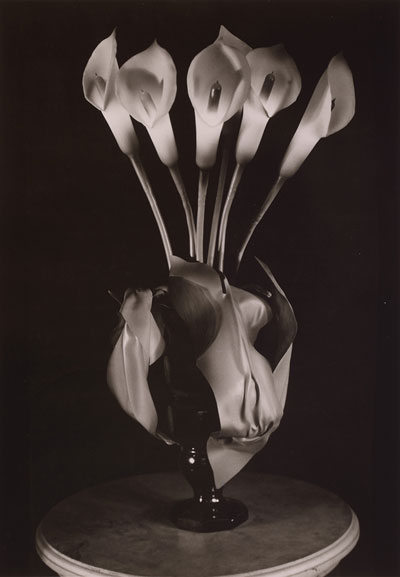
In 1917 she met the "poet-boxer," Arthur Cravan, with whom she embarked
on a passionate affair. Cravan fled to Mexico to avoid the draft; Loy
followed as soon as her divorce was final, and they married in 1918.
Pregnant, she traveled to Buenos Aires to have the baby and await Cravan's
joining her, but he never arrived. He was presumed drowned in the
makeshift boat he was using to sail to Argentina. Loy returned to England
to give birth to a daughter, Fabienne, and then returned to New York
where she continued her involvement with the Provincetown Players and
contributed to avant garde publications like The Dial and The Blind Man.
Her next decades were peripatetic, moving from Paris back to New York,
where she became a naturalized U.S. citizen and open a lamp design studio
where she made lamp shades from found objects. She continued to write
and work on her assemblages until her death at the age of eighty-three in
1966 in Aspen, Colorado, where she had gone to live in her final years.
"BUT the Future is only dark from the outside. Leap into it - And it
EXPLODES with Light," Mina writes in a collection of Aphorisms on
Futurism in the exhibit. And, indeed, the small, single gallery exhibition
seems to be bursting its seams with a symphony of ideas, images and
explorations.
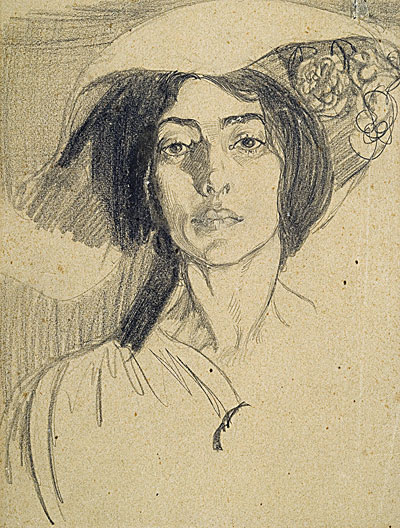
There are the many portraits of Mina – both self-portraits and those by her
circle of colleagues and admirers. One of the earliest is Mina's own 1905
graphite on brown paper, Devant le Miroir, which shows her developing
draughtsmanship in her first Paris years. Among the other interesting
perspectives are photographs of her as a girl, of Haweis and Loy in a Paris
art class in 1905 captured by her lover of the moment, and Haweis' gelatin
silver print of his wife in dark clothing seated near her easel.
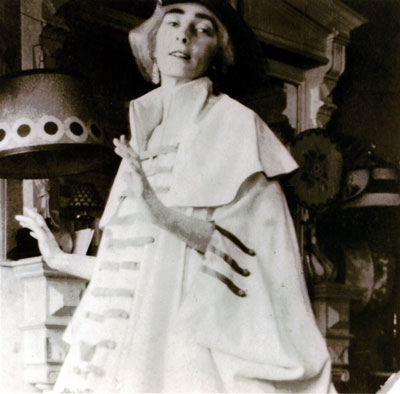
Mina Loy at The Blindman's Ball is a 1917 photograph of the artist
playfully attired as a lampshade – a way of publicizing her new business of
designing lamps and lampshades, which would flower into a gallery in
Paris and continue to the end of her life in America.. The ball launched the
Dada publication, The Blind Man, to which Loy contributed work.
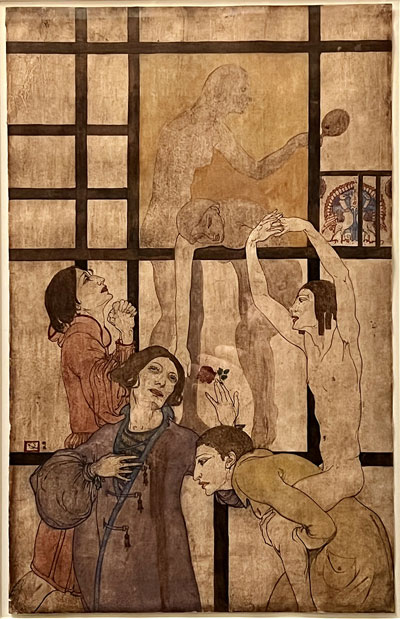
La Maison en Papier, gouache and graphite from 1906 which
demonstrates Loy's abiding interest in the female form, and the
intersection of design and art. The composition which includes nudes with
fashionably dressed ladies against a Mondrian-like geometric backdrop is a
startling study of women in a variety of theatrical poses evoking dance, the
circus, and pure domesticity.
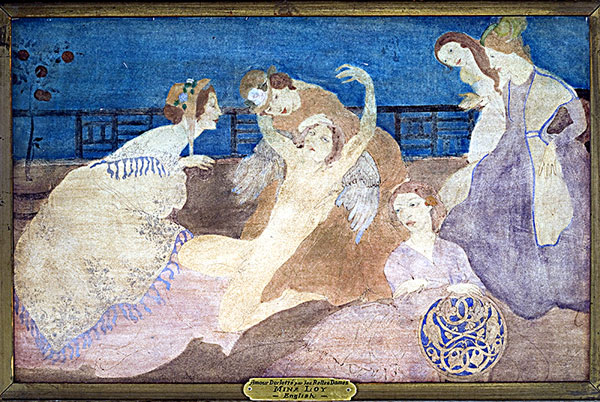
A similarly strange composition from 1916 is entitled L'Amour, is a
grouping of well-dressed women on a balcony with a nude female in an
erotic pose. The composition recalls the odalisques of Spanish tradition
and the more modern cubist prefiguring of Cezanne.
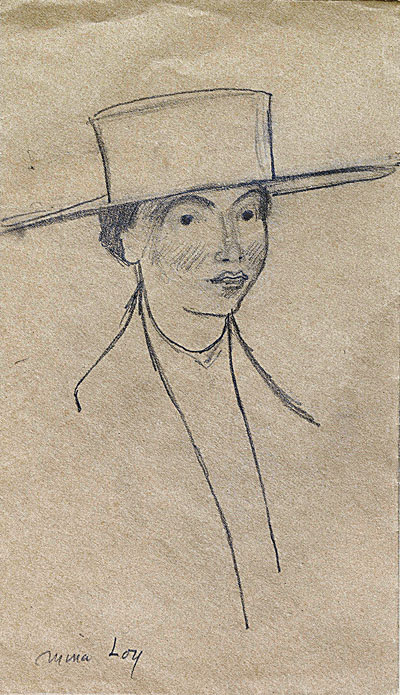
A very simple pencil sketch from the same year gives a penetrating portrait
of the poet Marianne Moore. Said Loy's friend, William Carlos Williams,
"Of all those writing poetry in American at the time [Loy] was here,
Marianne Moore was the only one Mina Loy feared. By divergent virtues,
these two women have achieved freshness of presentation, novelty,
freedom, break with banality." The utter unadorned nature of the drawing
seems to suggest at once Loy's respect for Moore and a sense of deep
comprehension.
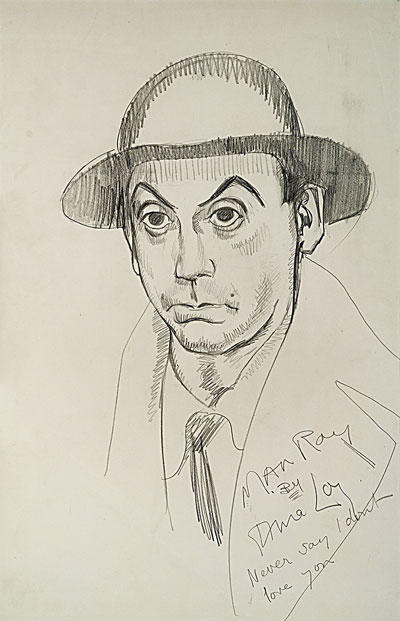
Loy's pencil portrait of Man Ray from 1925 has the same disarming
honesty, but there is a feeling of greater intimacy between artist and
subject, and the drawing is inscribed "Never say I don't love you." Ray has
a quizzical expression and deep, dark eyes. Ray returned the compliment
in a lovely photographic print of Loy wearing a thermometer as a dangling
earring. The zero reading on the instrument may suggest Loy's cool and
detached manner or her unflappable nature.
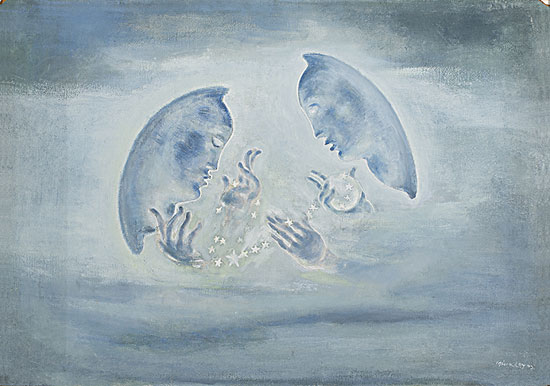
Moons (1932) is a mixed media on board painting in an abstract vein. The
soothing blue of the composition draws its color scheme from Picasso's
earlier Blue Period, but its iconography is all Dada and Surrealism. Moon
imagery was a significant motif in Loy's poetry and writing. Her Lunar
Baedeker and Time Tables was a meta-terrestrial poetic journey with
almost hallucinatory imagery that is at once sensual, erotic, and
provocative.
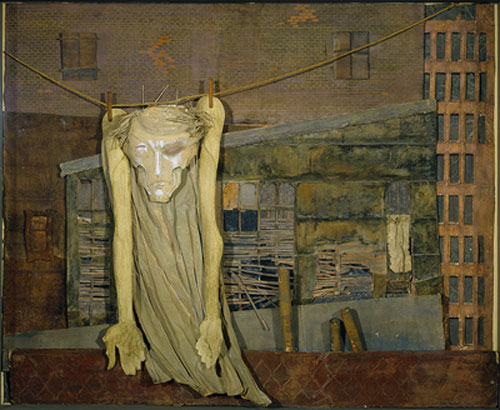
Among her powerful late work that uses collage and found objects is Christ
on a Clothesline (c. 1949). Instead of a cross, a simple clothesline becomes
the instrument of hanging for a face lined with suffering, as if imprinted on
Veronica's Veil. Done during the time that Loy was living in the Bowery, it
reflects her belief in the presence of divinity in the humblest of
circumstances and the sacredness of suffering that the artist sees all
around her.
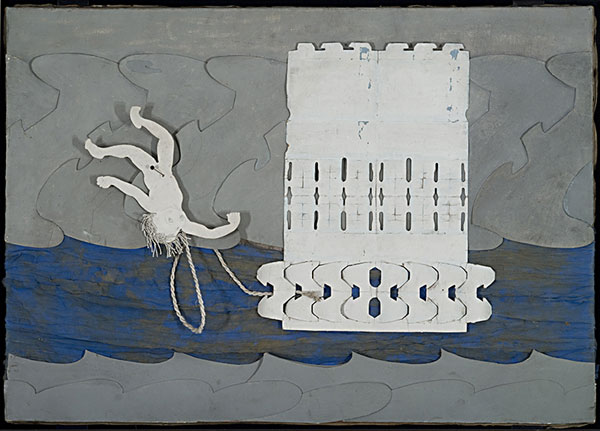
In The Drifting Tower (1950) a floating figure is tethered to a tower that
pierces the sky in a bright opening in the banks of gray clouds. Visually,
the collage reminds of the Surrealists, referencing Ray, Duchamp, Arp,
Ernst, and Calder. Thematically, the work poses the perplexing question of
whether the human figure's flight of fancy is restrained by mundane things
or whether the figure is being pulled away from the mundane by a "castle
of imagination"?
The richness of the exhibition is compelling and profound. There are
manuscripts by Loy, by James Joyce, Arthur Cravan, Marianne Moore,
Gertrude Stein, Edgar Allen Poe, and William Carlos Williams; there are
portraits and photographs by Alfred Stieglitz, Carl Van Vechten, Constantin
Brancusi; there are videos of Loy in her old age combing flea markets for
found objects. There is a sweeping sense of history: of a century where
two world wars, industrialization and numerous inventions, travel into
space, social upheavels rapidly transformed daily life and mores. There is
a beguiling sense of intimacy among the artist and her subjects and among
those who chose to observe Loy in return. Most of all, there is a sizzling
sense of originality, eclecticism, kinetic embrace of change, and a daring
acceptance of the unknown.
Loy once said that "art was a protest." She railed against convention,
patriarchy, poverty, and silence. To be an artist was to have the sacred
power to break that silence. On a scrap of paper she scribbled, "We only
excel in our moments of creation….the material world is the cemetery of
solids that have dropped from the eternal motion of creation."
As critic Lauren Moya Ford wrote of the current exhibition: "The world is
finally ready for Mina Loy." Loy, however, has been defining the future
now for more than a century and a half.
Mina Loy: Strangeness Is Inevitable is on view at the Bowdoin College
Museum, Brunswick, ME until September 17, 2023:
https://www.bowdoin.edu/art-museum/
|